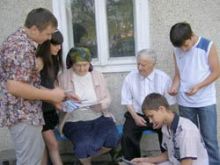In 1991, when Ukraine just gained independence, President Leonid Kravchuk came to Babyn Yar to say words of grief and compassion and apologized before Jews on behalf of the entire Ukrainian people for the crime committed by the German occupants on the territory of Ukraine.
There were thousands of Ukrainians who risked their lives and sacrificed themselves, rescued and hid Jews – representatives of an ethnic group with whom our people have lived side by side for centuries. Some of these Ukrainians are now named Righteous among the Nations. This title, according to the Israeli law “On the Memory of the Catastrophe,” is conferred on non-Jews, who in the years of Nazi occupation of Europe rescued Jews from persecution. The Day is carrying two stories about the Righteous among the Nations – one from Chernivtsi and the other one from Kirovohrad, while there are thousands of them. Let us commemorate and thank these people.
The village Ispas of Vyzhnytsia raion, Chernivtsi oblast, is located on the picturesque bank of the Cheremosh River. The village is populous; at the beginning of the previous century, over 2,000 people resided there, which was a significant figure in those times. Newcomers were attracted by the favorable location of Ispas, which lies on the road going from Chernivtsi to Vyzhnytsia and further to the Ivano-Frankivsk region and Galicia, which was part of another state at the time. So, besides Ukrainians, Ispas was a place of residence for Romanian families, Poles, Jews, and Armenians. They all treated each other in a friendly way. Houses of families with different ethnic background stood side-by-side, so women went to their neighbors to borrow matches or a pinch of salt and exchanged recipes of national dishes, while their children attended the same school and played with each other after classes.
“At school I sat at one desk with a Jewish girl, Rivka Herstel,” says Vasylyna Denys, recalling her childhood years. “As we lived close, we often came to see each other: Rivka’s mother treated us to kartoplianyky (potato pancakes). At the time, all of us wore national costumes, so we, as girls of any time, liked to exchange clothes. We hid in my house behind the stove and exchanged our clothes. I remember that Rivka was fond of my embroidered shirts.”
The peaceful life of the Ispas residents was ruined by World War II. The region was again occupied by Romania, an ally of Hitler’s Germany, and the persecution of Jews started. In July 1941, local members of the pro-Fascist organization Kuzi organized a bloody massacre in the villages Milieve and Banyliv, which were near Ispas.
“From there a band of 20 men, armed with pitchforks, scythes, and axes (I remember that only one of them was carrying a rifle) rushed to our village,” recalls Tanasii Shtefiuk, an eyewitness of those events.
His father Ivan Shtefiuk was the first to learn the news. Wheelchair-bound, this man enjoyed great authority among the villagers. He immediately sent his children for the village headman, priest, and other respectful men. They had to decide together how to defend their Jewish co-villagers.
The negotiations with the aggressors took place in the house which is still standing in one of the village’s central streets.
“The men were refusing to leave for a long while,” Tanasii says. “They boasted about how they had killed Jews in their villages: their narrations still make blood curdle. They tried to instigate my father and other residents of Ispas to give them a possibility to ‘purify’ our village, too. But our men held their own ground and succeeded in making the murderers go away. In spite of that, just in case, the villagers hid the Jews for a couple of days. I remember that two girls were hiding in our threshing barn, which stood in the garden, and my mother brought food and warm clothes to them.”
Finally, 15 Jewish families were rescued: 2,000 residents of Ispas risked their lives to save 100 people.
The members of the International Tolerance Foundation, which conducts surveys on the history of the Holocaust in different countries of the world, learned about the deed of the village’s residents. The center initiated erecting a monument to “the collective righteous”: the ceremony of laying foundation of the future monument was held in 2008.
The foundation did not limit itself to this effort only. Children from the Israeli city Sderot visited Ispas, while grandchildren of Ispas residents who saved their Jewish co-villagers in wartime went to Israel in exchange. All the residents of the village were named Righteous among the Nations.







